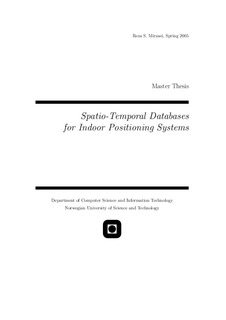| dc.contributor.advisor | Svanæs, Dag | nb_NO |
| dc.contributor.advisor | Trætteberg, Hallvard | nb_NO |
| dc.contributor.author | Mirzaei, Reza Shanbehbazari | nb_NO |
| dc.date.accessioned | 2014-12-19T13:32:51Z | |
| dc.date.available | 2014-12-19T13:32:51Z | |
| dc.date.created | 2010-09-03 | nb_NO |
| dc.date.issued | 2005 | nb_NO |
| dc.identifier | 348022 | nb_NO |
| dc.identifier | ntnudaim:955 | nb_NO |
| dc.identifier.uri | http://hdl.handle.net/11250/250880 | |
| dc.description.abstract | We have discussed two related topics in this thesis: the design of location models and spatio-temporal databases for indoor positioning systems. We conclude our work with a short recapitulation of the main issues presented and a justification of the limitations, followed by suggestions for further research and our final thoughts. 8.1 Location Modeling Different aspects of location modeling were discussed, among them symbolic, geometric and hybrid location models. We found that only the hybrid form is suited for our purposes, that is to accurately position objects within a domain and relay this information to users in an understandable way. As a modeling technique, we proposed a solution using basic constructs of UML with added extensions. We created a domain model containing objects and relationships between them which we deem as relevant for indoor location aware systems, including the geometric extent of locations and transitions. 8.2 Spatio-Temporal Databases We defined spatio-temporal databases as databases which manage data on geometrical objects that change (movement is also considered as a form of change). Although research in this area has received much attention in the past decade, no functional spatio-temporal systems are available. Purely spatial database systems however are. We therefore proposed a solution based on timestamping spatial data, thus capturing its temporal aspects and in effect making it spatio-temporal. In order to create a conceptual model of such a database for indoor location aware applications, we used our own domain model for location modeling and proposed extensions to it in order to capture specific spatial, temporal and spatio-temporal aspects. We used the conceptual model to create a prototype database, demonstrating the concepts proposed by us. | nb_NO |
| dc.language | eng | nb_NO |
| dc.publisher | Institutt for datateknikk og informasjonsvitenskap | nb_NO |
| dc.subject | ntnudaim | no_NO |
| dc.subject | MIT informatikk | no_NO |
| dc.subject | Systemarbeid og menneske-maskin-interaksjon | no_NO |
| dc.title | Spatio-Temporal Databases for Indoor Positioning Systems | nb_NO |
| dc.type | Master thesis | nb_NO |
| dc.source.pagenumber | 143 | nb_NO |
| dc.contributor.department | Norges teknisk-naturvitenskapelige universitet, Fakultet for informasjonsteknologi, matematikk og elektroteknikk, Institutt for datateknikk og informasjonsvitenskap | nb_NO |
